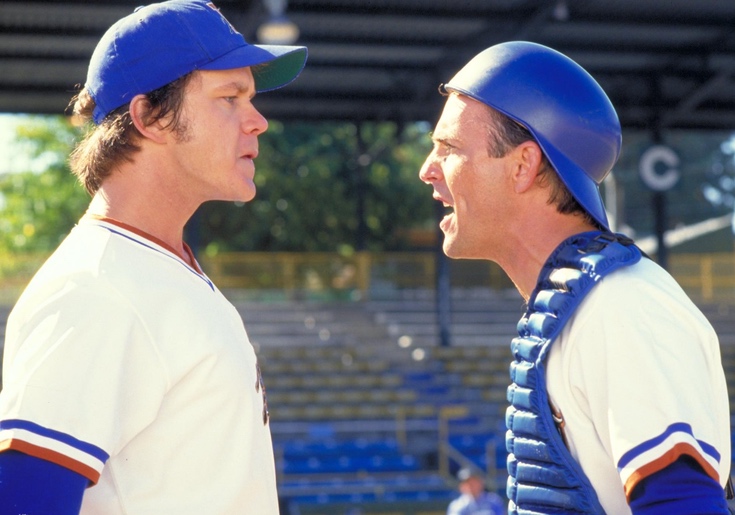In 1990, Saturday Night Live aired a sketch called "George F. Will’s Sports Machine," running just after the release of Will’s marvelous study of baseball, Men at Work. Dana Carvey plays Will as the host of a baseball trivia show with Corbin Bernsen’s Mike Schmidt and Jon Lovitz’s Tommy LaSorda as contestants and a raucous crowd of sports fans in the studio audience. Carvey-as-Will asks questions like "the precarious balance between infield and outfield suggests a perfect symmetry. For $50, identify the effect of that symmetry." The answer to that question, to the confusion of the contestants and the blank stares of the audience, is "the exhilarating tension between being and becoming."
Will is not the only writer to expend much ink on the national pastime. Baseball has attracted myriad lettered men, not just high-school lettermen. Stephen Crane, Jack Kerouac, and, importantly, Walt Whitman all took a shining to the boys of summer.
Screenwriter, director, and former minor-league shortstop Ron Shelton is one of these bookish types, as his recently published The Church of Baseball: The Making of Bull Durham suggests. Beginning with his childhood in a Baptist household, through his time in the Baltimore Orioles organization, to the Sisyphean-seeming task of developing his 1988 film, Shelton references the Western literary canon, the films of Akira Kurosawa, and nonsense poetry between retrospectives on baseball history.
As much as baseball draws the ardor of learned men, its locker rooms are often hostile to displays of intelligence. Shelton’s minor league manager speaks suspiciously of "college guys." One of the more amusing memories Shelton recounts comes when he learns to conceal his fondness for the written word—he hides his books in adult magazines to seem like "one of the guys." Funnily enough, Shelton only knew to do that because of Jim Bouton’s Ball Four, a journal of the former professional pitcher’s 1969 season, in which Bouton "talked about the importance of being ‘one of the guys’ so that the organization didn’t think you were an agitator or, worse, a clubhouse lawyer."
We should not confuse Shelton for some kind of Athenian philosopher—the memories he recalls of a young man basking in his own supposed perspicacity betray a certain self-righteousness, as exhibited in one postgame interview-turned-soapbox speech during his playing days. The broadcaster asks him about his home state of California, to which Shelton replies, "Yes, I’m from California, a state that has lost more young men than any other state in this ill-conceived adventure in neocolonialism in Indo-China."
It is only someone like Shelton—who can expound on the human condition with aplomb but also uses his platform as a professional baseball player to try to "bury the hawkish argument of the domino theory and give a short primer on the corruption of the Nguyen Cao Ky regime"—who could have written Bull Durham, a film at once perceptive and puerile, profound and preachy. It’s Kevin Costner and Susan Sarandon waxing melodramatic about what they "believe in." It’s the eye-roll-inducing soliloquies and gratuitous Whitman quotes. But it’s also the raw, emotional experience of a ballplayer being let go by the team and the toll a life on the road takes on a relationship.
Those latter experiences are what led Shelton to create Bull Durham. Sports movies "all seemed to be made from an outsider’s point of view." These films never seemed to touch on the internal monologue running through a batter’s head, for instance, or the personal travails professional athletes encounter.
"What happens on the field is the least interesting part of the game," Shelton writes. Whether or not he consciously realizes it, Shelton makes a similar argument throughout The Church of Baseball: What happens on the screen is the least interesting part of the film.
Shelton regales the reader with stories of financing—Kevin Costner himself has to meet with studio representatives in order to secure the film’s funding—and casting—Susan Sarandon is not on "The List" and has to make an appearance at the Orion Pictures headquarters to convince bigwigs she "looks good." (Studio executives preferred Kim Basinger.)
The most exciting of these tales comes when a producer tells Sarandon the studio thinks she doesn’t look good in a close-up. In a manifestation of the same anti-establishment derision Shelton harbors toward "the organization" in his playing days, he grabs the producer by the collar and takes him to the ground, scolding him for talking to Shelton’s actors. Somehow, it worked. "Nobody spoke with the actors again, except the director."
The Church of Baseball is not the only book to offer a glimpse into the baseball dugout or the Hollywood writers’ room. Michael Lewis’s Moneyball and William Goldman’s Adventures in the Screen Trade, among plenty other titles, do just that. None do both at once, though, and Shelton’s offers a character study, to boot. The subject, however, isn’t any of his Bull Durham characters. It is Ron Shelton himself: during his journey through the purgatory that is minor-league baseball to the strikingly similar experience of making a film, in the exhilarating tension between being and becoming.
The Church of Baseball: The Making of Bull Durham: Home Runs, Bad Calls, Crazy Fights, Big Swings, and a Hit
by Ron Shelton
Knopf, 256 pp., $30
Zach Kessel is a student at Northwestern University’s Medill School of Journalism, where he serves as president of the campus Alexander Hamilton Society chapter.
